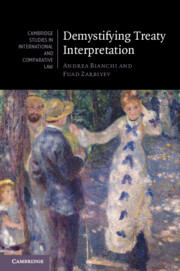Book contents
- Demystifying Treaty Interpretation
- Cambridge Studies in International and Comparative Law: 188
- Demystifying Treaty Interpretation
- Copyright page
- Contents
- Figures
- Preface
- Abbreviations
- 1 The Province of the Rules of Treaty Interpretation
- 2 The Interpreter’s Self
- 3 The Genealogy of the Contemporary Regime of Treaty Interpretation
- 4 Textualism
- 5 Intentionalism
- 6 What’s the Purpose of ‘Object and Purpose’?
- 7 Supplementary Means
- 8 The Magic of Systemic Integration
- 9 Inferential Reasoning and Its Consequences
- 10 Time and Treaty Interpretation
- 11 Text, Author, and Interpretive Control
- 12 Power, Persuasion, and Authority
- Annex Vienna Convention on the Law of Treaties 1969
- Index
- Cambridge Studies in International and Comparative Law
2 - The Interpreter’s Self
Freedom and Constraints
Published online by Cambridge University Press: 07 March 2024
- Demystifying Treaty Interpretation
- Cambridge Studies in International and Comparative Law: 188
- Demystifying Treaty Interpretation
- Copyright page
- Contents
- Figures
- Preface
- Abbreviations
- 1 The Province of the Rules of Treaty Interpretation
- 2 The Interpreter’s Self
- 3 The Genealogy of the Contemporary Regime of Treaty Interpretation
- 4 Textualism
- 5 Intentionalism
- 6 What’s the Purpose of ‘Object and Purpose’?
- 7 Supplementary Means
- 8 The Magic of Systemic Integration
- 9 Inferential Reasoning and Its Consequences
- 10 Time and Treaty Interpretation
- 11 Text, Author, and Interpretive Control
- 12 Power, Persuasion, and Authority
- Annex Vienna Convention on the Law of Treaties 1969
- Index
- Cambridge Studies in International and Comparative Law
Summary
Most writings about treaty interpretation in international law are about how treaty interpretation should proceed and how treaty interpreters are constrained by various rules that discipline the interpretive exercise. Chapter 1 showed why rules by themselves cannot determine what treaty interpretation is and how it should proceed. This does not mean, however, that international lawyers are wrong in their self-perception that treaty interpretation is a constrained activity. This chapter argues that international lawyers have been looking for the source of interpretative constraints in the wrong place and that the actual interpretive constraints come from the fact that treaty interpretation is never the work of an isolated interpreter, but an exercise performed by a member of an interpretive community that determines what counts as a legitimate interpretation.
Information
- Type
- Chapter
- Information
- Demystifying Treaty Interpretation , pp. 23 - 48Publisher: Cambridge University PressPrint publication year: 2024
